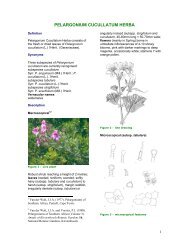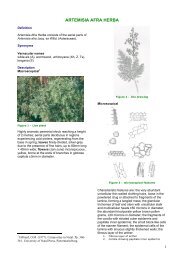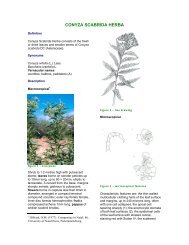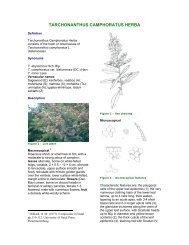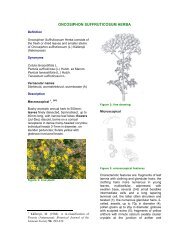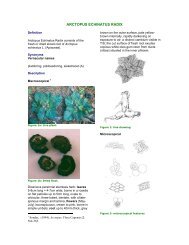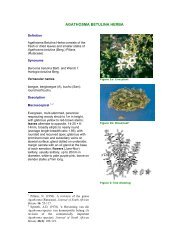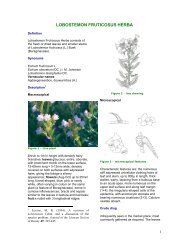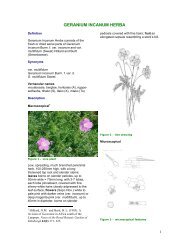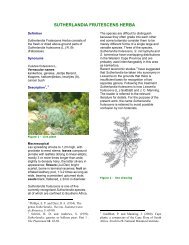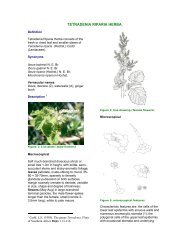AGATHOSMA CRENULATA HERBA - PlantZAfrica
AGATHOSMA CRENULATA HERBA - PlantZAfrica
AGATHOSMA CRENULATA HERBA - PlantZAfrica
Create successful ePaper yourself
Turn your PDF publications into a flip-book with our unique Google optimized e-Paper software.
<strong>AGATHOSMA</strong> <strong>CRENULATA</strong> <strong>HERBA</strong><br />
Definition<br />
Agathosma Crenulata Herba consists of the<br />
fresh or dried leaves and smaller stems of<br />
Agathosma crenulata (L.) Pillans (Rutaceae)<br />
Synonyms<br />
Barosma crenulata Hook.<br />
Barosma serratifolia (Vent.) Willd.<br />
Vernacular names<br />
Buchu, long leaf buchu, oval buchu<br />
Description<br />
Macroscopical 1 , 2<br />
Single-stemmed aromatic shrub to 2.5m or<br />
more in height, with glabrous or sparsely<br />
pubescent branches, the latter light green<br />
when young to dark brown when older;<br />
leaves opposite, erect-spreading, glabrous,<br />
15-30 × 7.5-13.0mm; length:breadth ratio 2-<br />
3 (Av: 2.34); ovate-lanceolate to obovate,<br />
with apex rounded but not recurved and<br />
serrate margin; scattered schizo-lysigenous<br />
oil glands clearly visible on lower surface<br />
and at leaf margins; flowers (Jun-Nov)<br />
white to mauve, axillary, 1-3 on short stalks,<br />
petals 7-9mm long, ovate, obtuse.<br />
Figure 2: line drawing<br />
Microscopical<br />
Figure 3: microscopical features<br />
Figure 1: Live plant<br />
1<br />
Pillans, N. (1950). A revision of the genus<br />
Agathosma (Rutaceae). Journal of South African<br />
Botany 16: 55-117.<br />
2 Spreeth, A.D. (1976). ʼn Hersiening van die<br />
Agathosma-species van kommersiële belang (A<br />
revision of the commercially important<br />
Agathosma species). Journal of South African<br />
Botany 42(2): 109-119.<br />
This species is similar to A. betulina in<br />
having anomocytic stomata on the lower leaf<br />
surface only and in the presence of a distinct<br />
crystal layer of calcium oxalate rosette<br />
aggregates in the mesophyll parenchyma; it<br />
differs from the former in the absence of<br />
diosmin sphaerocrystals in cells of the leaf<br />
lamina; spherical oil glands are visible at the<br />
base of each tooth of the serrate leaf<br />
margin.<br />
1. T/S of leaf lamina showing single palisade<br />
layer and calcium oxalate rosette aggregates<br />
in cells of the mesophyll.<br />
2. Epidermal cells of lower leaf surface with<br />
anonocytic stomata.<br />
3. Mesophyll cells with calcium oxalate cluster<br />
crystals.
Crude drug<br />
Collected when required or available in the<br />
marketplace as bundles of leafy twigs;<br />
colour light yellow-green, odour highly<br />
aromatic, texture soft when fresh, leathery<br />
when dry; leaf surface gland dotted.<br />
Geographical distribution<br />
Cool sheltered ravines of middle mountain<br />
slopes and valleys of the Western Cape<br />
Province, from Ceres and Tulbagh<br />
southwards to Wolseley, Paarl, Wellington,<br />
Stellenbosch, Betty’s Bay, Caledon and east<br />
as far as Worcester. The distribution range<br />
of this species overlaps with that of A.<br />
betulina in the Ceres/Tulbagh district, but A.<br />
crenulata generally occurs in heavier soils,<br />
often near streams.<br />
Figure 5: HPLC structure<br />
Retention times (mins): 6.46, 6.65, 10.87<br />
Essential oil content: not less than 1.5%<br />
(range: 1.32-2.19-4.0% GR1 )<br />
Purity tests<br />
Assay<br />
Figure 4: distribution map<br />
Quality standards<br />
Identity tests<br />
Thin layer chromatography on silica gel<br />
using as solvent a mixture of toluene:diethyl<br />
ether:1.75M acetic acid (1:1:1). Reference<br />
compound cineole (0,1% in chloroform).<br />
Method according to Appendix 2a.<br />
R f values of major compounds: 0,34<br />
(orange); 0,39 (orange-yellow); 0,43 (light<br />
blue); 0,47 (light green); rutin marker:0,34<br />
(orange)<br />
HPLC on C 18 column, method according to<br />
Appendix 2b.<br />
Major compounds:<br />
Methanol extract:<br />
None available. Assay methods for buchu oil<br />
3, 4, 5<br />
have been published.<br />
Major chemical constituents<br />
Little is known of leaf secondary chemistry<br />
other than the essential oil, of which the<br />
major constituents are limonene (9.0-1.8%),<br />
menthone/isomenthone (6.49-28.0%),<br />
pulegone/isopulegone (51.4-60.0%) and<br />
both cis- and trans- 8-acetylthio-pmenthane-3-one<br />
(7.03%). Neither<br />
diosphenol/ψ-diosphenol (“buchu camphor”)<br />
nor the 8-mercapto-p-menthane-3-ones,<br />
characteristic of A. betulina, have been<br />
detected in the oil of this species. 3,4,5<br />
3 Kaiser, R., Lamparsky, D. and Schudel, P.<br />
(1975). Analysis of buchu leaf oil. Journal of<br />
Agricultural and Food Chemistry 23(5): 943-<br />
950.<br />
4<br />
Blommaert, K.L.J. and Bartel, E. (1976).<br />
Chemotaxonomic aapects of the buchu series<br />
Agathosma betulina Pillans and A. crenulata<br />
Pillans from local plantings. Journal of South<br />
African Botany 42(2): 121-126.<br />
5<br />
Posthumus, M.A. van Beek, T.A., Collins, N.F.<br />
and Graven, E.H. (1996). Chemical composition<br />
of the essential oils of Agathosma betulina, A.<br />
crenulata and an A. betulina × crenulata hybrid<br />
(Buchu). Journal of Essential Oil Research 8:<br />
223-228.
Figure 6: chemical structures<br />
Dosage forms<br />
Agathosma crenulata is used in traditional<br />
practice in the same manner as (and<br />
interchangeably with) A. betulina. For details<br />
regarding dosage forms, see monograph on<br />
latter species.<br />
Medicinal uses<br />
In South Africa, A. crenulata is used for the<br />
same purpose as A. betulina i.e. for the<br />
treatment of urinary and respiratory tract<br />
infections, rheumatism, sprains and bruising,<br />
fever and as a diuretic GR1, 19, 20, 23 . Although<br />
allowed by the British Pharmacopoeia<br />
(1963) as a suitable substitute for A.<br />
betulina, this herb has never featured<br />
prominently in other pharmacopoeias of<br />
Europe. The reason for this may be<br />
historical rather than scientific and<br />
efficacy/toxicity profiles of both species are<br />
necessary. In the food industry, the essential<br />
oil of A. betulina is preferred to that of A.<br />
crenulata as a flavourant; this has to do with<br />
the blackcurrant “note” imparted to the<br />
former by traces of mercapto-p-menthaneones.<br />
cells. Similar extracts exhibited no direct<br />
inhibitory effect on either HSV-1 at dilutions<br />
higher than 1/333, or Coxsackie B2 virus<br />
replication.<br />
An in vitro study of antimicrobial activity<br />
found the essential oil (10µl/well) to possess<br />
weak activity against Escherichia coli,<br />
Staphylococcus aureus and Saccharomyces<br />
cerevisiae but none against Enterococcus<br />
hirae or Pseudomonas aeruginosa 5 . In the<br />
same study, initial smooth muscle<br />
spasmogenic activity (guinea pig ileum),<br />
followed by spasmolysis, was demonstrated<br />
for the essential oil (concentration range<br />
4×10 -6 to 8 ×10 -5 v/v in methanol).<br />
Spasmolytic action was dose related, with<br />
an IC50 of 8×10 -6 .<br />
Contraindications<br />
See monograph on Agathosma Betulina<br />
Herba.<br />
Adverse reactions<br />
See monograph on Agathosma Betulina<br />
Herba.<br />
Precautions<br />
See monograph on Agathosma Betulina<br />
Herba. In view of the higher concentrations<br />
of pulegone/isopulegone in the essential oil<br />
of A. crenulata as compared with that of A.<br />
betulina, long term use of Agathosma<br />
crenulata preparations is not recommended.<br />
Dosage<br />
See monograph on Agathosma Betulina<br />
Herba.<br />
Pharmacology/bioactivity<br />
Only one scientific study appears to have<br />
been made of whole plant bioactivity 4 . The<br />
results showed that aqueous extracts of<br />
Agathosma crenulata were not cytoxic to<br />
HeLa, Vero, Jurkat E6.1, AA-2 or CEM-SS<br />
4 Treurnicht, F. T. (1997). An evaluation of the<br />
toxic and potential antiviral effects of some<br />
plants used by South Africans for medicinal<br />
purposes. MSc thesis, University of<br />
Stellenbosch.<br />
Copyright in this monograph resides with the authors, the South<br />
African National Biodiversity Institute, the South African Medical<br />
Research Council and the University of the Western Cape. It may<br />
not be reproduced in whole or in part without the written consent of<br />
the copyright holders.<br />
5 Lis-Balchin, M. and Simpson, S.H. (2001).<br />
Buchu (Agathosma betulina and A. crenulata,<br />
Rutaceae) essential oils: their pharmacological<br />
action on guinea pig ileum and antimicrobial<br />
activity on micro-organisms. Journal of<br />
Pharmacy and Pharmacology 53(4):579-582.



